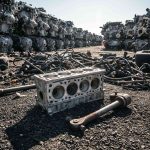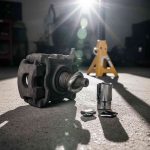The Mystery Behind Expensive Tiny Plastic Clips
You walk into a salvage yard near me, armed with your tools and ready to save money on car repairs. You spot that tiny plastic door trim clip you desperately need – it’s smaller than a quarter and weighs almost nothing. Then comes the sticker shock: $16.26. Your jaw drops. How can something so small cost more than a fast-food meal?
This frustrating scenario plays out daily at junkyards across America, leaving DIY mechanics scratching their heads. The truth behind junkyard pricing isn’t as mysterious as it seems – it’s all about operational efficiency and category-based systems that prioritize simplicity over individual part value.
How Salvage Yards Really Price Their Parts
Most self-service junkyards don’t price parts individually. Instead, they use a category-based pricing system that groups similar items together. That tiny plastic clip falls under broad categories like “TRIM PIECE,” “SMALL PART,” or “LATCH,” regardless of its actual size or material cost.
| Part Category | Price Range | What’s Included |
|---|---|---|
| Fender Flare/Trim | $16.26 | All exterior trim pieces |
| Latch | $8.78 | Door, hood, trunk latches |
| Hood Prop Rod | $8.77 | Small supporting parts |
| Small Parts Labor | Variable | Miscellaneous clips and fasteners |
This system exists because salvage yards deal with thousands of unique, unbarcoded items daily. Imagine trying to individually price every clip, fastener, and sensor from hundreds of different car models – the administrative overhead would be astronomical.
The Economics Behind the “Small Parts Problem”
Several economic factors contribute to seemingly overpriced small parts at U-Pull-It yards:
- Vehicle Processing Costs: Every car entering the yard requires inspection, draining of fluids, and preparation
- Labor and Overhead: Staff wages, facility maintenance, and environmental compliance add to operational costs
- Profit Margin Requirements: Yards typically aim for 4-5 times their acquisition cost as markup
- Category Subsidization: High-value items within a category help offset the cost of lower-value parts
“Salvage yards price based on the type of item being pulled and the popularity of the model. It’s common for yards to have two prices: a low price if you remove the part yourself, and a higher price if the part has already been removed by yard staff.”
Auto Recycling Industry Expert
Why New Plastic Parts Are Also Expensive
Before criticizing junkyard prices, consider that new OEM plastic parts often cost even more. A simple door clip from a dealership might cost $25-40 because of:
- Engineering and Design Costs: Each clip is specifically designed for particular models
- Small Batch Manufacturing: Low production volumes increase per-unit costs
- Quality Testing: OEM parts undergo extensive durability testing
- Dealer Markup: Multiple profit layers from manufacturer to consumer
This high dealer pricing actually sets the ceiling for what salvage yards can charge, making their category-based pricing seem reasonable by comparison.
Understanding Junkyard Operations
Modern auto recycling facilities are sophisticated operations that handle complex inventory management challenges. Consider these operational realities:
| Operational Challenge | Impact on Pricing |
|---|---|
| No Universal Barcoding | Category-based pricing necessary |
| Inventory Turnover | Quick pricing decisions required |
| Staff Training | Simple systems reduce errors |
| Customer Volume | Fast checkout processes needed |
Research from industry studies shows that yards using individual part pricing spend 300% more time on inventory management compared to category-based systems. This efficiency gain allows them to offer affordable used auto parts overall, even if individual small parts seem expensive.
The Technology Gap in Auto Recycling
Unlike retail stores with sophisticated point-of-sale systems, most self-service yards operate with minimal technology infrastructure. According to recent data science research, the auto recycling industry lags significantly behind other sectors in adopting inventory management technologies.
- Manual Processing: Most parts are tagged and priced by hand
- Limited Databases: Few yards maintain comprehensive part catalogs
- Cash-Based Systems: Many locations still operate primarily on cash transactions
- Seasonal Fluctuations: Pricing adjusts based on scrap metal market conditions
Smart Strategies for Junkyard Shopping
Understanding the pricing system helps you make smarter decisions when finding high-quality auto parts. Here are expert strategies:
- Buy Multiple Parts: If you need several trim pieces, the category pricing becomes more reasonable
- Consider Alternatives: Look for similar clips from different areas of the same vehicle
- Bundle Purchases: Combine small parts with larger items to maximize value
- Time Your Visit: Many yards offer discounts and special deals on certain days
Some experienced mechanics note that small, easily 3D-printable plastic parts cost “10x more than they should” at yards, but this reflects the reality of operational efficiency rather than price gouging.
The Environmental and Economic Value
Despite frustrations with small part pricing, auto recycling provides immense environmental and economic benefits. The industry prevents millions of tons of waste from entering landfills while providing affordable alternatives to new parts.
When that tiny clip costs $16.26 at the junkyard versus $35+ from a dealer, the salvage yard option still represents significant savings. The research community continues studying ways to optimize these pricing systems for better consumer value.
Making Peace with Junkyard Economics
The frustration over expensive tiny clips stems from a fundamental misunderstanding of how salvage yard operations work. These businesses aren’t pricing parts based on material cost or size – they’re pricing them based on operational categories designed to ensure profitability across their entire inventory.
That seemingly overpriced clip helps subsidize other bargains throughout the yard. The engine you bought for $400 instead of $2,000 new? The transmission that saved you $1,500? Those deals are partially made possible by the higher margins on small parts.
“The gap between perceived value and actual cost creates customer frustration, but category-based pricing enables yards to offer significant savings on major parts while maintaining operational efficiency.”
Future of Junkyard Pricing
As technology advances and digital solutions become more affordable, some yards are experimenting with more sophisticated pricing models. However, the core challenge remains: balancing operational efficiency with customer satisfaction.
For now, understanding the system helps set proper expectations. When you need a replacement part and are deciding between a junkyard and other options, remember to calculate the total value proposition, not just the individual part cost.
If you’re looking to sell your old vehicle for cash, these same economic principles work in your favor – yards need inventory to maintain their parts supply, creating opportunities for vehicle owners to get fair compensation for their end-of-life cars.
The next time you encounter that expensive tiny plastic clip, you’ll understand it’s not about the clip itself – it’s about maintaining an entire ecosystem that keeps affordable auto parts flowing to DIY mechanics and professional shops alike. The system may not be perfect, but it serves a vital role in keeping older vehicles on the road and reducing automotive waste.





Leave a Reply
You must be logged in to post a comment.